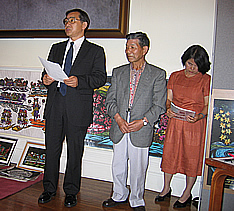 |
| Counsellor Motai delivers a speech |
Distinguished guests, ladies and gentlemen,
I would like to welcome you all here, to the Embassy of Japan, to the opening of an exhibition of kiri-e, paper-cutting art works of the Aomori Nebuta . The exhibition will continue until 30 July and tonight we are not only celebrating the opening of the exhibition but we are also privileged to have with us here the artist himself, Mr. Ogura, who will demonstrate something of his techniques.
You may well think of delicious red apples when you hear the name of Aomori Prefecture; and rightly so. However, these are not the only things which have made Aomori famous. As many of you will know, Aomori is also famous for the Nebuta Festival. The origins of the Nebuta Festival are lost in the mists of time. According to some authorities, nebuta are a means to frighten away enemies. On the face of it, the explanation seems quite plausible. At any rate, the festival is now a well-established and important event in the Aomori calendar. The people of Aomori make giant figures of heroes of the past from bamboo and translucent, coloured paper, lit from within. Each of these nebuta floats is supported on a platform and sturdy wheels and pushed by some twenty to thirty men.
Every year, more than three and half million people, not only from Japan from all around the world, crowd to the port city of Aomori to watch the nebuta parading through streets by night. Held for a whole week in early August every year, it is one of the best-known festivals in Japan and has grown from a local festival into one of great national importance. Floats from the festival have even been taken abroad.
As some of you may know, we have already been privileged to have witnessed, first-hand, a taste of the magnificent illuminated floats from the Nebuta Festival here in London. The most recent float was constructed in the British Museum in November 2001 as a part of Japan 2001 . We were able to see the float again, this time fully lit, accompanied by Haneto dancers, and the pride of the magnificent lantern parade during the Mayor's Thames Festival in 2002.
The powerful and vibrant paper-cuts of Mr. Mitsuo Ogura beautifully reflect the scale and vitality of the spectacular Nebuta Festival. As a native of Aomori, it is only natural that he chooses to depict scenes from this lively festival. The medium of kiri-e with its strong lines, bold designs and vivid contrasts, suitably lends itself to the expression of such heroic themes. As a long-established folk-art, variations of paper-cut art can be found throughout the world, most notably in China. In Japan, the bold and symbolic expression of kiri-e has its comparisons in the striking clarity of line found in the stencils used for textile dyeing and ukiyo-e woodblock printing.
Kiri-e lends itself to a variety of forms. Mr. Ogura's work not only includes images of nebuta but also plants, Buddhist images and birds.
One last and surprising thing is that Mr. Ogura is self-taught: he was not a born kiri-e artist and only started paper-cutting at the age of fifty-nine when he retired from engineering work on the Seikan Tunnel. He is now seventy-four. He would like this to be testament to the fact that it is never too late�ߡ�Doesn't this suggest such a lot!
I hope you will enjoy this beautiful and yet somewhat frightening Nebuta Kiri-e exhibition.
Related link:
Featured Events: Nebuta Kiri-e
|


